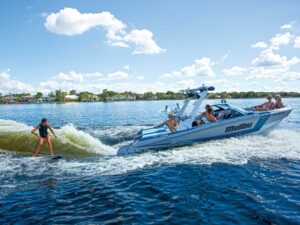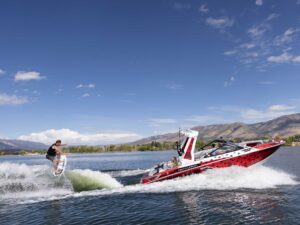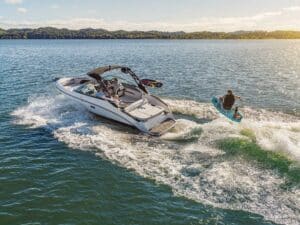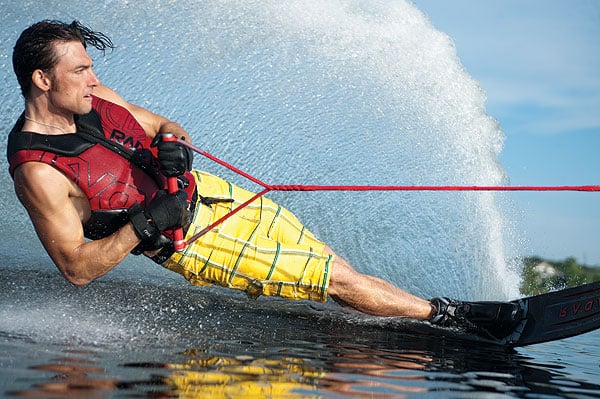
Ankle and knee injuries are part of a slalom skier‘s life, a seemingly unavoidable reality ominously lurking somewhere in the foreseeable future. While there does not appear to be a strong correlation between a specific binding type and frequency of injury, every skier has his or her own theory as to which setup is safest. Simply ensuring that your boots are properly fitted and adjusted to your size, weight and ability level could be your best defense against a season-ending injury.
Dr. David H. Nichols, a muscular-skeletal specialist based in Austin, Texas, has plenty of real-world slalom injury experience. A nationally ranked slalom skier with scores into 38 off himself, Nichols has treated scores of wounded amateur and professional skiers. “The most common injuries I encounter are to the knees and ankles — torn or strained ligaments, meniscal tears, patellar dislocations — some pretty bleak situations,” he says. While Nichols concedes that slalom skiers are prone to injury, regardless of binding preference, one prominent factor stands out. “In my experience, it always comes down to one foot releasing without the other. One leg versus the environment will usually end in injury,” he says.
Whether you opt for traditional rubber bindings or hardshells, it’s important to ensure that both feet can release with roughly the same amount of force. “There’s no such thing as a totally safe binding system,” ski and binding designer Mike Ferraro agrees. Mike has been a designer for Herb O’Brien for more than 30 years, and he currently works on Radar Skis’ design team as well. “It’s something of a catch-22, really; the stiffer the boot, the easier it is for you to stay on edge. A softer boot will likely offer an easier release in the case of a fall, but it will be at the cost of greater performance.” Ferraro has served as expert witness on behalf of the water-sports industry for numerous product liability cases. “I’ve seen every fall imaginable, on every binding configuration made. The bottom line is this: The nature of the opposing forces involved in this sport can cause injury, regardless of the bindings you use.”
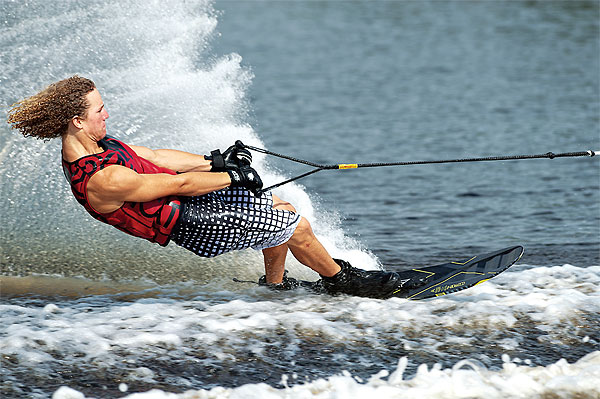
1. SINGLE BOOT/REAR TOE PIECE
The most classic setup for entry-level slalom skiers, this is the starting point for most beginners. While the vast majority of pro and amateur skiers graduate to a more modern binding configuration, there are certain benefits associated with the rear toe piece that double-booters will never understand. The back leg freedom specifically afforded to toe-strappers allows them to dramatically move their hips to find a more balanced, dynamic position through their turns.
2. DOUBLE BOOTS
Double boots have long been the natural progression for most skiers departing from the more traditional single-binding/ rear-toe-strap setup. Double bindings offer a more secure connection to the ski, allowing the skier to have equal power through both feet. Most skiers feel slightly less vulnerable during wake crossings and stronger through the finish of the turn. However, there are definite drawbacks associated with being more locked to the ski. With your back leg held solidly in place, it becomes more difficult to square your hips as you approach the turn.
3. HARDSHELLS
The most secure skier-and-ski interface is found among the many hardshell systems currently available. While there are many different ways to attach these boots to your ski, control and comfort are the unifying characteristics of these systems.
Every motion is transferred directly to your ski, allowing you to be far more efficient in your movements. However, for some skiers, this may be a detriment. Overloading the rope or overleaning happen quite easily due to the increased lateral control.
GET THE RIGHT BINDING SETUP
Bill porter of performance Ski & Surf (perfski.com) of Orlando, Florida, has sold thousands of bindings, so he knows what’s up in regard to getting the right setup. Bill puts his experience to use to help get your feet into the correct pair of boots.
What Is Your Ability Level?
The first step is to assess your current ability level and where you hope to take your skiing. You should select a binding configuration within this range. For instance, if you’re just learning to get up on a slalom ski, a double hard-boot setup would be far from ideal. It’s never wrong to up your performance level with new gear — as long as it’s within reason.
Who Will Be Using the Bindings?
Whether or not one or more additional people will be using your new boots will affect the decision-making process. There is no benefit to a fully moldable liner if several pairs of feet will be in and out of the bindings. You may have to make a small sacrifice in performance if several feet sizes and shapes will be using your boots.
Fit Is First
correctly sizing your boots is the best way to prevent injury. An ill-fitting boot will be less comfortable and could fail to release properly. Today’s boots are designed with comfort and function in mind. Gone are the days when running boots a few sizes too small is necessary to get optimum edge control. Always follow your manufacturer’s sizing guidelines.
Get ‘Em Wet First
Whenever possible, find a shop that will allow you to demo a pair of boots before you put down your cash. If you’re upgrading to a newer binding style, you will not feel comfortable straight out of the box. It will likely take a few sets to learn where to push and how to move in them.
Work With a Shop You Trust
You want to pick a pro shop that’s in a position to sell a number of different bindings from a number of different manufacturers. You want a shop staffed with skiers who use the products themselves and can give credible advice on how to narrow your search.

